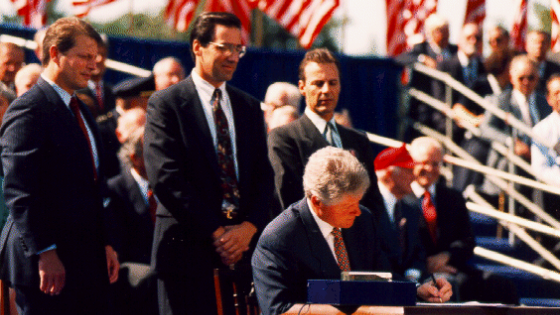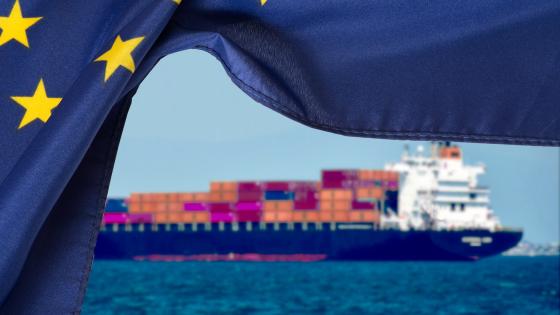The recent pace of globalisation has led to disheartening job loss for some Americans, especially in certain communities that backed Mr. Trump in the election. While imports and exports indisputably contribute big gains to the US economy overall, those resulting benefits have not been adequately shared.
However, even the largest estimates find international trade has caused only a fraction of the US economic dislocation — including that likely suffered by Mr. Trump’s key voters. Recognised studies observe that the surge in imports from China is an important contributor to US unemployment, for example, but it is responsible for less than 20% of the manufacturing job loss from 1999 to 2011. The other 80% of lost jobs were caused by something else entirely.1
Automation eliminated many routine blue-collar jobs. Americans have also begun to demand new goods, including cleaner energy, thereby shunning old standbys like coal. And after the financial crisis of 2007, the US housing boom ended, wiping out construction jobs. There was a tsunami of change, and it attacked the livelihood of a concentrated set of US workers and communities.
Suddenly, a nimbler US workforce was required; one that was more adept at engaging with the increasingly skill-intensive, computerised, and service-oriented economy. The US must now address two separate needs: it must help the currently displaced US workers while preparing the broader US labour force for the inevitable waves of change still to come.
But solutions will not be found in any trade agreement. Nor should they, as that is not what trade agreements do.
Trade agreements do not prevent the US government from implementing needed domestic policies
Before the Obama administration entered office in 2009, American workers were forced to rely almost exclusively on employer-provided health insurance. This made it more difficult for a worker to seek out a new job, and it also made involuntary job loss of any kind more disruptive.
The 2010 Affordable Care Act (ACA) was the largest expansion of the US social safety net in decades, and informed trade proponents hold it up as reducing one important impediment to worker mobility.2 Obamacare was a long overdue policy that supported the 21st century economy by making the US labour market more responsive to all forces of change.
Importantly, neither trade nor trade agreements impeded the ACA from coming into law in 2010.
The only role of the trade agreement was to compel the writers of Obamacare to think twice about how — and not whether — they were structuring the policy. Trade agreements force policymakers to confront the rhetorical question: Are we willing to bear the full financial and efficiency cost burden of the policy?
The trade agreement comes into play only if policymakers are implementing the policy because they think they can push its costs onto foreigners.
The job of the government’s trade lawyer, the US Trade Representative, is to advise senior US officials that a failure to take this cost-shifting into consideration will have economic consequences. In internal meetings, the US Trade Representative will point out that additional costs will arise. They include the lost US exports and jobs that result when trading partners receive legal permission to retaliate, because the US has broken the trade agreement’s rules.
Trade agreements can therefore impose a check on US legislators and regulators, but only by forcing them to structure their policy so that it does not have a discriminatory impact on activity taking place outside of US borders.
But trade agreements are needed because they reciprocally protect US-based exporting companies and their workers from foreign policymakers who would otherwise do the same thing.
It matters how trade agreements are enforced
Most US disputes follow a basic template: the US Trade Representative works on behalf of an American company and its workers that are seeking to open or re-open a foreign market to sell its goods or services.
Nevertheless, the difference in how the last two US administrations have prioritised their enforcement resources is telling.3
The strategy of the George W. Bush administration was to focus enforcement resources on older and more mature markets, filing nearly half of its WTO disputes against Canada, the EU and Japan. While important economic markets for US exporters and workers, these were slower-growing and already relatively law-abiding economies.
The Bush administration was also quite slow to build a pipeline of WTO enforcement cases against China. Despite China’s ever-growing economic importance, the country’s continued lack of transparency, and US concerns that China’s undervalued currency unfairly promoted Chinese exports, the first US-initiated dispute to reach a legal ruling arrived only in 2008. This was nearly seven full years after China’s permitted entry into the WTO.
Quite differently, the Obama administration fought all its trade disputes against either China or some other emerging economy. These disputes are in line with the broader ‘pivot to Asia’ that has sought expansion of American influence and economic opportunity in a fast-growing but underrepresented region. By picking these trading partners, the administration is enforcing the rights of US workers and companies to sell in relatively new and important markets of the future, where the rule of law has lagged.
Trade agreements do not prevent governments from directly helping address dislocated workers
As President-elect Trump gets ready to enter office, many aspects of the US job market show signs of improvement. At 5%, US unemployment is less than half the Great Recession peak reached in 2009. Out of a US labour force of 160 million, relatively few people that have been actively searching for a job are now unable to find one.
The more acute problem is the steadily increasing number of working-age American men without a college education who have stopped looking for employment and who thus do not show up in the unemployment statistics. Some have transitioned off the rolls of unemployment insurance to receive benefits under the government’s disability insurance programme.4
Nothing in US trade agreements prevents fixing the US social safety net to better assist those disadvantaged by automation, changes in the types of goods and services that the global economy now demands or even trade.
Indeed, the Affordable Care Act of 2010 was one important step in this direction. Obamacare made health insurance more portable for workers, even in the event of job loss. Simply repealing it would introduce a new source of economic uncertainty for millions of already anxious Americans.
Other improvements to the responsiveness of the US labour market are also needed. Expanded educational opportunities, such as apprenticeship and employer-subsidised training programmes, are important for continued maintenance and skill-building for the US workforce.
The existing Earned Income Tax Credit programme tops-up the wages of low-income household in the workforce. However, its current coverage is limited by design; expanding coverage would help advance the prospects of the working poor.
Wage insurance programmes have long been proposed to assist displaced workers who are willing to transition to new employment that pays less than what they earned at their lost job. Dropping out for almost any reason quickly leads to a decline in health outcomes and the costly atrophy of workplace skills. Making these programmes available to all displaced workers – and not just those displaced by globalisation — is important and would also incentivise remaining in the workforce.
Finally, it is also critical that the new administration and Congress make good on promises to fund needed investment in America’s decaying infrastructure. President Obama’s efforts were stymied during much of the last eight years; such investments are needed to raise productivity for the overall economy through easing the movement of workers, goods and services within the US. A focus on smart public construction, maintenance, and repair would also temporarily address the surfeit of non-college educated, working-age men who are currently on the outside looking in.
Don’t renege. Renegotiate trade agreements
A US withdrawal from NAFTA or the WTO5 would lead to Mexico or other trading partners’ retaliation — as witnessed in the 1930s — and likely a sharp fall in US exports. A new category of American workers at exporting companies would join those already suffering.
If the incoming administration is serious about renegotiating NAFTA, it would find it worthwhile to examine a few elements of the much-vilified Trans-Pacific Partnership (TPP). The TPP agreement — while now shelved by Congress — included efforts to help level the playing field for productive, albeit relatively costly, US workers.
The TPP’s innovation was to require a trading partner like Mexico to also have laws – like those found in the US – that establish the rights of local workers to unionise and bargain collectively.6 TPP also required Mexico to pass legislation on safe working conditions and minimum wages and to end employment discrimination and forced labour. Similar requirements were written into the TPP on environmental standards.
Final lessons
Globalisation has led to a larger and richer US economy. Trade is what makes it financially possible for the US government to have more resources to address these other problems. Paying for the needed investment in US workers, their communities and infrastructure is feasible economically if the US remains open.
As the 1930s experience with the Smoot-Hawley tariffs and international retaliation revealed, US trade agreements are mainly important because everyone — even Americans — are foreigners somewhere.7 For US companies and their workers in the 21st century economy, 95% of the world’s potential customers continue to live outside of US borders.
Trade agreements remain critical because that beggar-thy-neighbour temptation for governments — in the US, but especially elsewhere — never goes away.8
And that temptation will surely resurface if the US is the first to rip them up.
Editors’ note: This column has been edited and condensed from version published by PBS NewsHour at http://www.pbs.org/newshour/making-sense/column-truth-trade-agreements-need/
References
Acemoglu, D, D Autor, D Dorn, G H. Hanson, and B Price (2016) “Import Competition and the Great US Employment Sag of the 2000s,” Journal of Labor Economics 34(S1): S141-S198
Autor, D H (2015) “The unsustainable rise of the disability rolls in the United States: causes, consequences and policy options,” in Social Policies in an Age of Austerity: A Comparative Analysis of the US and Korea, Edited by John Karl Scholz, Hyungypo Moon and Sang-Hyup Lee. Cheltenham, UK: Edward Elgar (Chapter 5).
Autor, D, D Dorn, and G Hanson (2013) “The China Syndrome: Local Labor Market Effects of Import Competition in the United States,” American Economic Review 103(6): 2121-2168.
Autor, D, D Dorn, and G Hanson (2016) “The China Shock: Learning about Labor Market Adjustment to Large Changes in Trade,” Annual Review of Economics 8: 205-240.
Bagwell, K, C P Bown and R W Staiger (2016) “Is the WTO Passé?,” Journal of Economic Literature 54(4): 1125-1231.
Bown, C P (forthcoming) “Mega-Regional Trade Agreements and the Future of the WTO,” Global Policy.
Cimino-Isaacs, C (2016) “Labor Standards in the TPP,” in Trans-Pacific Partnership: An Assessment, Edited by Cathleen Cimino-Isaacs and Jeffrey J. Schott. Washington, DC: Peterson Institute for International Economics (Chapter 15).
Irwin, D A (2011) Peddling Protectionism: Smoot-Hawley and The Great Depression. Princeton, NJ: Princeton University Press.
Irwin, D A (2012) Trade Policy Disaster: Lessons from the 1930s. Cambridge, MA: MIT Press.
Krueger, A B (2016) “Where Have All the Workers Gone?” Mimeo, Princeton University, October.
NBC (2016) “Meet the Press - July 24, 2016,” Transcript of television program.
Rivlin, A (2015) “What the ACA has achieved and what’s next,” Mimeo, The Brookings Institution, December 21.
WTO (2016) “Disputes by country/territory,” last accessed 15 November.
Endnotes
[1] See Acemoglu et al. (2016) as well as Autor et al. (2013, 2016).
[2] Rivlin (2015) provides a brief introduction to the Affordable Care Act.
[3] Computed by the author with data on U.S.-initiated WTO disputes made available from WTO (2016).
[4] For a discussion of the declining share of non-college educated prime age men in the U.S. labor force, see Krueger (2016). Autor (2015) describes the historical increase in take-up of the US disability insurance program, as well as the incentives involved in the program.
[5] In a 24 July 2016 television interview, when confronted by the concern that his proposal for new import tariffs on Mexico and China would likely be deemed as inconsistent with U.S. legal obligations under the WTO, Donald Trump responded by saying “It doesn't matter. Then we're going to renegotiate or we're going to pull out. These trade deals are a disaster, Chuck [Todd]. World Trade Organization is a disaster.” (NBC 2016).
[6] For a discussion of the TPP labor provisions, see Cimino-Isaacs (2016). For a more general discussion of the mega-regional trade agreements of the TPP, Transatlantic Trade and Investment Partnership (TTIP) negotiations, as well as the WTO, see Bown (forthcoming).
[7] For a discussion of the trade policy disaster of the 1930s in the Great Depression period that did not have trade agreements, see Irwin (2011, 2012).
[8] See Bagwell et al. (2016) for a review of the economics literature on trade agreements, and especially they role they are understood to play in addressing international cost-shifting motives arising through terms-of-trade and other international externalities.



